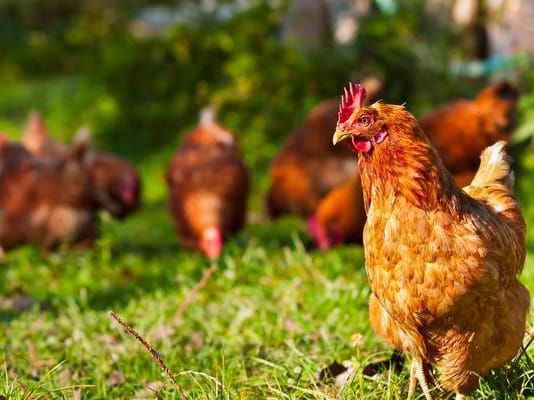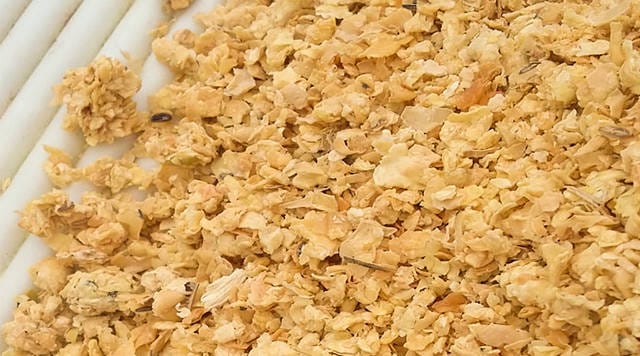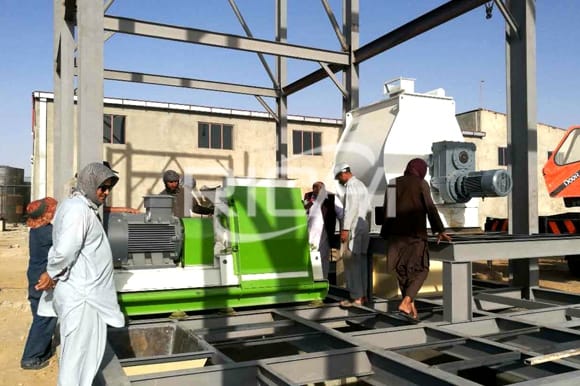Laying hen feed formulations are mainly formulated with corn, wheat bran, soybean meal, dicalcium phosphate, stone powder, salt, additives, etc. in a certain proportion. The feed additives contain amino acids, vitamin trace elements and growth promoters. All raw material processing and finished products must comply with green guidelines for the use of food feed and feed additives.

一、What kind of feed do hens mainly eat?
-
1. Protein feed. The concept of protein feed is that the natural moisture content is less than 45%, the crude fiber in dry matter is less than 18%, and the crude protein content in dry matter reaches or exceeds 20% of the feed. For example, beans, cakes, and fish meal are all classified as protein feed. According to different sources, protein feed can be divided into four categories: plant-based protein feed, animal-based protein feed, single-cell protein feed and non-protein nitrogen feed.
It seems that there are many types, in fact, cake meal feed is the main source of protein feed in the breeding industry, such as soybean meal, bean cake, cottonseed cake and so on. In addition, animal protein feeds with a relatively low dosage mainly include fish meal, blood meal, bone meal, hydrolyzed feather meal, silkworm pupae, insect feed, etc. Among them, fish meal is the main one.
-
2. Energy feed. Energy feed refers to feed whose crude fiber content is less than 18% and crude protein is less than 20%. Such as cereals, bran, starchy roots and tubers, dross, and liquid molasses, whey and fats and so on.
-
3. Green and juicy feed. The first two categories are based on protein content, and the succulent green succulent feed cannot be classified together with the first two categories. However, the succulent green succulent feed is indeed used in the production of chickens, especially in the native chicken or stocking mode. The frequency is higher. The definition of green fodder is fresh forage grass and pasture with a natural moisture content of more than 60%. This type of feed has a wide source, high yield, low cost, rich in vitamins, young and juicy, and good palatability. Such as alfalfa, chicory, ryegrass, aquatic green feed, vegetables.
-
4. Roots, tubers, melon feed and silage. Roots, tubers, and melon feeds such as sweet potatoes, potatoes, beets, carrots, and pumpkins are generally used in stocking mode. Silage is generally not used in the chicken industry.

二、Problems with laying hen feed
However, in the production process of laying hens, there is emphasis on protein and light energy, and the utilization rate of feed protein is ignored. Some chicken farmers' feed formula remains unchanged, and some excessively add some trace ingredients. Let's talk about the specific problems of laying hens, and hope that customers of laying hen feed manufacturing plant or chicken farms can learn from them.
-
1. The feed formula remains unchanged. The feed formula should be adjusted according to the season and the feed intake of the flocks. It cannot be fixed. When the feed intake is small, the various nutrients in the feed should be increased. It can be seen from the following formula that the nutrient composition in the feed changes with changes in feed intake. Formula: feed intake × feed nutrient content = fixed number (the daily nutrients required for each chicken are constant).
The high temperature in summer causes the feed intake of laying hens to decrease, and the concentration of nutrients in the feed is appropriately increased. The increase depends on the decrease in feed intake, which generally increases by about 5%-10%. For example, the protein and metabolic energy levels at the peak of egg production should be adjusted from 16.5% and 11.5 MJ/kg to 17.6% and 12.3 MJ/kg, respectively.
It is best to add a small amount of fat to the feed of laying hens, which can not only increase the metabolic energy value, but also promote feeding, reduce body heat, and promote the absorption of nutrients. It is also possible to replace stone powder with shell powder of reliable quality, and to mix stone powder and shell powder so that the ratio of shell powder to stone powder is about 1:3-4. For raw materials that do not contain protein and energy, such as zeolite powder and maifan stone powder To use less, the amount should not exceed 3%.
The heat or heat stress of laying hens except for bacitracin zinc is allowed to be used in conventional feed, and other antibiotic drugs should be restricted. Studies have shown that allicin (essential oil) can inhibit or kill a variety of staphylococci, dysentery bacillus, E. coli, typhoid bacillus, fungi, viruses, amoeba, coccidia, and pinworm, especially for dysentery and Enteritis has a good curative effect, and promotes feeding, digestion, and egg production. In addition, allicin can be combined with vitamin B1 to prevent the latter from being destroyed, so it can increase the absorption of effective vitamin B1. Natural garlic can be added directly (with skin) in laying hen feed at a rate of 1%-2%. The raw gypsum is grinded into fine powder and mixed at a feed rate of 0.3%-1.0%.
-
2. Pay attention to protein and despise energy. In daily feed formulations, energy and protein are the two main elements of feed and are very important. In a sense, energy is more important than protein. Energy determines the egg production rate of chickens, and protein determines the size of egg weight. The energy of chickens plays a leading role in maintaining survival and production. When the protein in the feed is too high, while the protein is decomposed into energy, a large amount of uric acid is also produced, causing gout in the chicken, and at the same time increasing the cost of feed. Therefore, high-protein low-energy feed is not high-quality feed. To ensure the balance of energy and protein; let energy and protein do their responsibilities.
-
3. Excessive addition of some trace ingredients The feed contains various trace ingredients such as vitamins and trace elements. These ingredients are not too good. Too much addition will increase the cost, on the other hand, it may affect the absorption of related nutrients. Therefore, the principle adopted for these substances is to reduce more and supplement less.
-
4. Ignore the utilization of feed protein. The nutrition of protein in feed is actually different amino acid composition and different utilization rate. When formulating feed, you must consider whether the utilization of protein used and the composition of amino acid are balanced, otherwise protein deficiency is prone to occur, and even peculiar food such as feather pecking.
-
5. Precautions for concentrated feed preparation
Laying hen poultry chicken broiler animal feed pellet making plant usually design 20%-40% concentrate. If the proportion is too low, the type of feed that the user needs to match increases, the cost seems too high, and it is not easy for the feed factory to control the final product; if the proportion is too high, it will lose the meaning of concentration.
Normally, layer chicks are designed with 30%-50% concentrated feed, grown chickens 30%-40%, and laying chickens 35%-40%. There are two calculation methods: one is calculated from compound feed; the other is calculated from a set ratio, and then formulated according to this ratio. When using concentrated materials, users should follow the recommended formula of laying hen poultry animal feed processing plant, so that quality control is easy. Due to changes in raw materials, users should re-calculate the ratio to meet the main indicators.

Recommend several formulas for layer feed:
-
1. Chicken (1-60 days) recipe:
- ① 62% corn, 10% bran, 17% bean cake, 9% fish meal, 2% bone meal.
- ② Corn 60%, bran 10%, bean cake 22%, fish meal 6%, bone meal 2%.
-
2. Formula for young chicken (61-120 days):
- ① Corn 55%, bran 20%, bean cake 7%, cottonseed cake 5%, rapeseed cake 5%, fish meal 5%, bone meal 2%, shellfish meal 1%.
- ② Corn 66%, bean cake 18%, sunflower seed meal 11%, fish meal 3%, bone meal 1.5%, table salt 0.5%.
-
3. Feed formula during egg production:
- ① Corn 56%, miscellaneous grains 10%, bran 6%, bean cake 17%, fish meal 5%, shellfish powder 3%, Qingshizi 3% (methionine 0.1%, table salt 0.4%).
- ② Corn 68%, bran 6%, bean cake 8%, fish meal 10%, bone meal 2%, shellfish powder 6%.
Now we know the feed formula of laying hens. Feed is an important part of laying hen chicken feed processing plant, which is related to the growth and development of laying hens. Therefore, understanding the nutritional composition of laying hen feeds and making a reasonable ratio are beneficial to laying hens. Growth also has a direct effect on egg production.
You can also choose to browse these contents:


